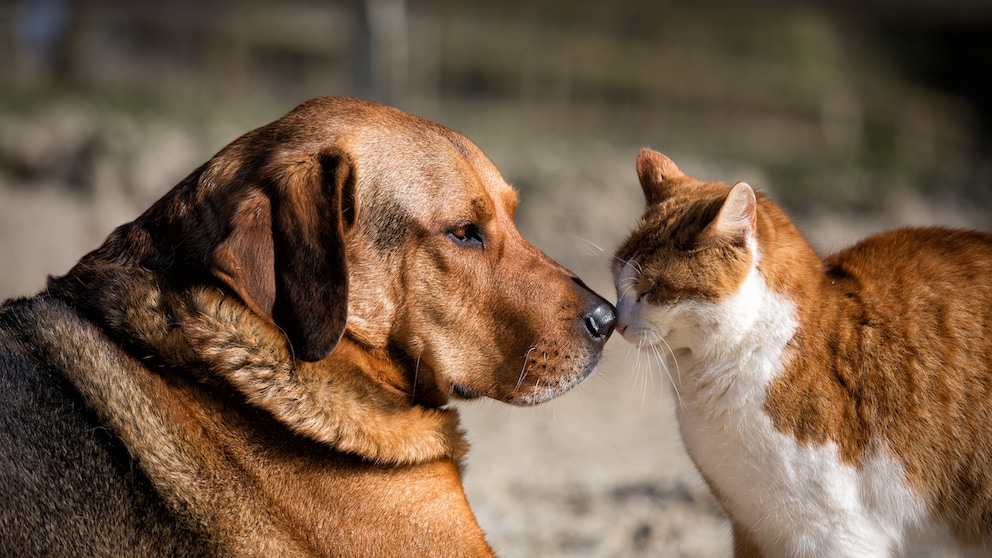October 16, 2024, 9:52 am | Read time: 4 minutes
There are lots of tips and advice on how to get cats and dogs used to each other. A study from England has now investigated for the first time what really matters. PETBOOK editor and biologist Saskia Schneider presents the exciting results and classifies them.
Dogs and cats are often portrayed as natural enemies, and there’s some truth to that. In the wild, cats are definitely prey for wolves, but also for larger dogs. The differences in their body language can often lead to misunderstandings when they interact. Nevertheless, dogs and cats can get used to each other. After all, there are millions of cats and dogs in the world who live together peacefully in the same household. However, this is not always a matter of course. For the first time, a team of researchers from England has investigated the key factors in successful socialization between dogs and cats.
Two factors influence how dogs behave toward cats
The scientists evaluated data from approximately 4,500 puppies that interacted with cats. The study, called “Dog Trust,” was part of the “Generation Pup” project, in which over 9,000 puppies are followed throughout their lives, and their health and behavior are scientifically documented.
When evaluating the data, the factors influencing the puppies’ behavior towards cats were examined. The study revealed that the pace of introduction and the puppy’s age play crucial roles.
90 percent of the puppies showed “undesirable behavior”
The project was led by Dr. Rachel Casey. She is a veterinarian, a European specialist in veterinary behavioral medicine, and an animal welfare scientist. In an article in the British daily newspaper The Guardian, Casey says that the vast majority of dogs showed “undesirable” behavior when they were first introduced to a cat.
This included aggressive or overly assertive behavior, like attempting to play with a cat that was not interested. Fewer than 10 percent of the puppies that encountered cats remained calm and relaxed.
Don’t just let them run free
The study’s findings underscore the importance of carefully acclimating cats and dogs to one another. Otherwise, the situation can quickly develop to the cat’s disadvantage. But how should things be done correctly, according to the scientists?
“The advice is to do it really gradually,” Dr. Rachel Casey told PA Media news agency. This is because the study found that around a fifth (20.1 percent) of pet owners immediately introduced their new puppy to their existing cats, which in itself is not wrong. Yet, in 18.9 percent of cases, this introduction occurred in under two hours. However, the gradual introduction of puppies and cats significantly increased the likelihood of dogs and cats getting used to each other and getting along, according to the study.
Getting dogs used to cats early and in small steps
According to the results, puppies that are brought into contact with cats for more than one day are calmer and friendlier. According to the study, this is particularly true for animals younger than twelve weeks. This could contribute to a more harmonious relationship. Therefore, the study suggests introducing your puppy to a cat as early as possible and in incremental steps.
These results also correspond to what is observed in behavioral biology. Dogs and cats are still in the so-called imprinting phase at the age of twelve weeks. They are still open to new stimuli and situations. If they have positive experiences in this context, this shapes their behavior for life.
Conversely, a puppy that has negative experiences with cats, such as getting too close and feeling claws or teeth, will likely require considerable effort to foster a good relationship with cats, and the close friendship that many desire between these animals may never materialize.

Can Stress Cause Cancer for Dogs? What the Experts Say

Not love or money! Large study shows which factor really keeps dogs healthy for a long time

This factor has the greatest influence on a dog’s lifespan
Cats must have the opportunity to get out of the way
It is thus crucial to always provide the cat with an escape route during encounters, preventing situations where it may feel compelled to defend itself from an overly curious or assertive dog.
Casey further stresses this point: “Ideally, the cat should be in a position to escape,” the veterinarian advises. It’s important that the cat can get out of the dog’s way, ideally by jumping up somewhere so that it doesn’t feel threatened by the puppy.
“Teaching the puppy to remain calm in the cat’s presence is essential,” she adds. The scientist presented the results of her study on October 12 at the “New Scientist Live 2024” conference in London.

